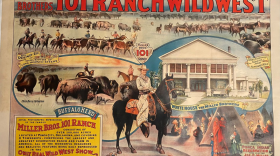On this date in 1915, North Dakota news centered on the opening of the state fair in Grand Forks. Weather predictions promised perfect conditions, and excitement was in the air across the state. But also on this date that year, war was raging in Europe. Newspaper readers became familiar with the impending fall of Warsaw to the German forces and the coal strike in Wales.
As dire as it was for the people of Europe, the war offered economic benefits for North Dakota farmers, who planted every possible acre to produce enough to feed the world. America became the world’s breadbasket, and North Dakota was central to that effort.
But the state’s farmers contributed more than food. Allied military forces had to cope with shortages of all manner of supplies. That included horses and mules. Historians estimate that as many as six million animals were used in the war. They served in the cavalry and pulled artillery pieces, supply wagons and ambulances. The demand created a shortage of horse power. The value of horses and mules, and the difficulty of replacing them, led some soldiers to believe the animals were more valued than the soldiers themselves.
Early in the war Great Britain requisitioned horses from civilians, but that was not sufficient to meet the need. So, horses were imported from Australia, Canada, and the United States. Between 1914 and 1918 almost a million horses were shipped from the U.S., and no small number came from North Dakota.
On this date in 1915, the Grand Forks Daily Herald reported that buyers for the French and English armies had gone to Marmarth to purchase horses. This was their second trip. They had come the previous fall, and at that time, they were quite particular and rejected most of the offered animals. However, as it became a major effort to replace horses lost in the war, the buyers had to set their standards lower. On this second trip to Marmarth, they purchased all but a handful of the available horses.
After the United States entered the war in 1917, North Dakota provided much more to the war effort, but war horses may have been one of the most important contributions.
Dakota Datebook written by Carole Butcher.\
Sources:
State Historical Society of North Dakota. “World War I in North Dakota.” https://www.history.nd.gov/nhdinnd/turningpoints/WWIinND.html Accessed 6/20/20.
International Museum of the Horse. “The Horse in Transition.” http://imh.org/legacy-of-the-horse/the-horse-in-world-war-i-1914-1918/ Accessed 6/20/20.
Grand Forks Daily Herald. “Horses Previously Rejected Taken.” Grand Forks ND. 7/20/1915. Page 4.



